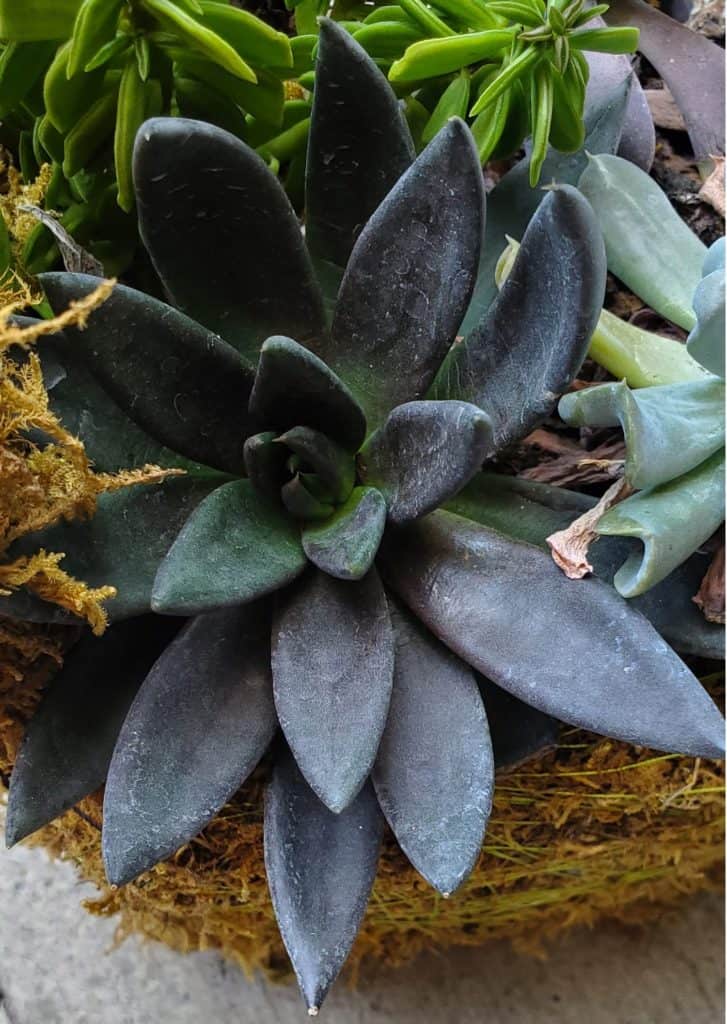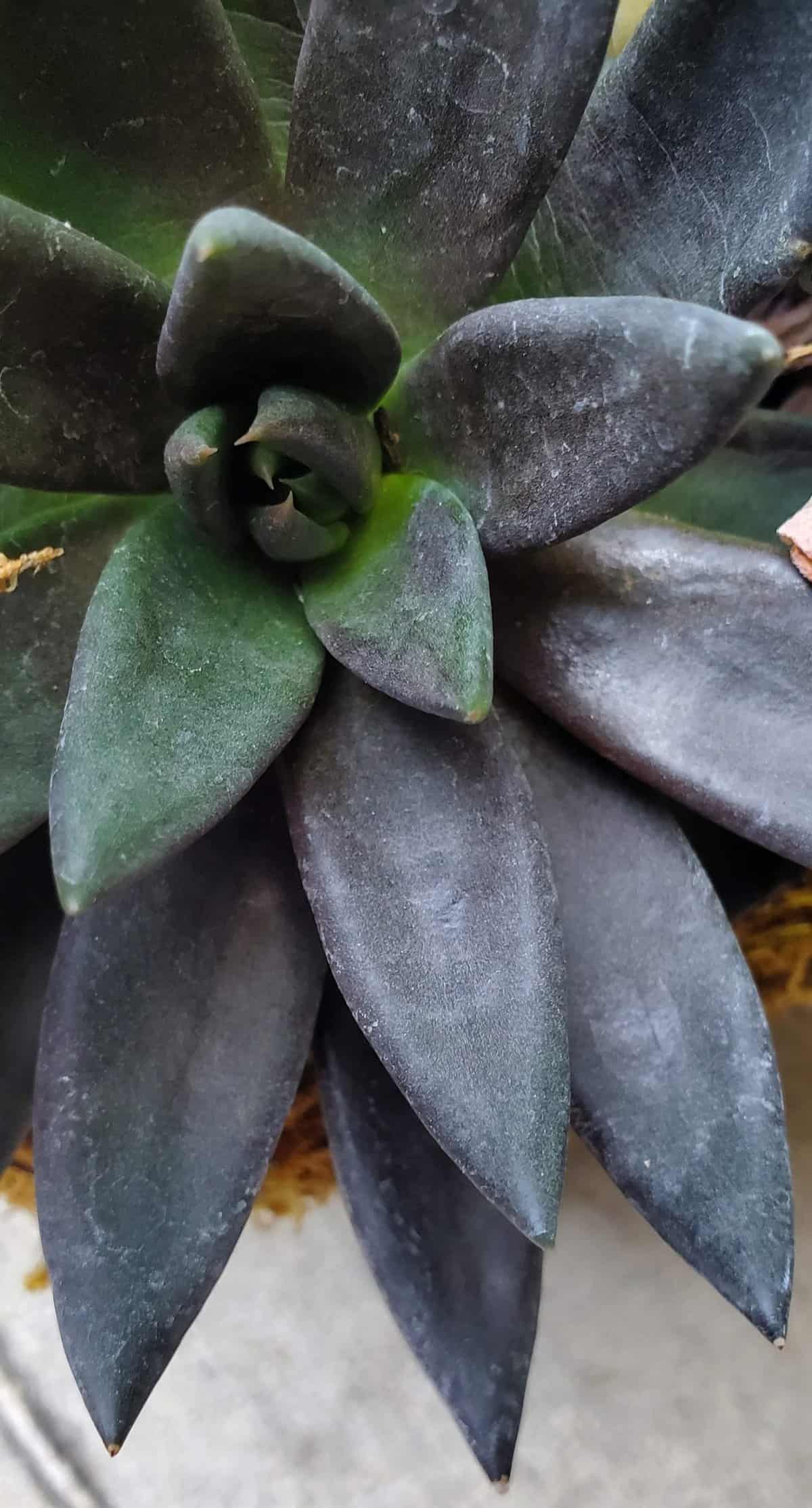Echeveria ‘Black Knight’ – Info & Complete Care Guide
I absolutely love shopping online for succulents and gardening supplies. If you aren't already saving money by comparing prices online, give it a try! Here are six of my favorite things that I have purchased online as I build my own succulent oasis:
When I found an echeveria ‘black knight’ on the clearance shelves of Home Depot, I was floored. It was the first time I had seen the plant in person and it was gorgeous! The deep purple leaves were so dark they were almost black, and they were offset by a beautiful mossy green. I knew I had to have it.
I brought it home and potted it up, and it has been doing great ever since. If you’re looking for a dramatic addition to your succulent collection, ‘black knight’ is definitely the plant for you. The echeveria ‘black knight’ is a beautiful plant that is perfect for gardeners of all levels of experience.
I’m sharing a complete step-by-step guide on how to grow and care for your echeveria ‘black knight’. I will cover everything from the plant’s physical description and growing season to its watering and sunlight needs. I’ll also provide tips on propagating your echeveria ‘black knight’ and troubleshooting common problems.
Scientific Name
Echeveria ‘black knight’
Common Name
Echeveria affinis E. Walther
Related: Succulent Types with Pictures
Physical Description of Echeveria ‘Black Knight’

The echeveria ‘black knight’ is a succulent that is native to Mexico and Central America. It is a member of the Crassulaceae family and can grow up to six inches tall and eight inches wide.
The leaves of the echeveria ‘black knight’ are dark purple in color, and when given enough sun, appear almost black. The center of the plant is a vibrant shade of green, and the leaves come to a V-shape with one tiny “spike” on the end of each one. The black knight blooms in the summertime displaying a bright pink flower.
You can check your local garden centers and greenhouses, but finding an echeveria ‘black knight’ in stock can be rare. You might need to shop around online to find the right selection.
Where to Buy Echeveria 'Black Knight'
If you're looking to add more plants to your collection, you can usually buy succulents of all kinds at these stores.
Growing Season of Echeveria ‘Black Knight’
Echeveria ‘black knights’ can be grown indoors or outdoors. If you are growing your plant indoors, it is best to do so in a sunny spot. If you are growing your plant outdoors, it should be placed in an area that receives partial sun. The ideal temperature for growing an echeveria ‘black knight’ is between 70 and 85 degrees Fahrenheit, but it can survive temperatures as low as 50 degrees Fahrenheit.
How to Care for Echeveria ‘Black Knight’
Perhaps the most important thing to remember when caring for an echeveria ‘black knight’ is that it is a succulent. This means that it does not need a lot of water. In fact, overwatering is one of the most common problems faced by gardeners who are new to growing succulents.
Watering Needs of Echeveria ‘Black Knight’
The echeveria ‘black knight’ does not need a lot of water. The best way to water your succulent is to drench it, and then wait until the soil is completely dry before watering again. During the hotter months, you may need to water your plant once per week. During the cooler months, you may only need to water your plant once every two weeks. It is always better to err on the side of underwatering rather than overwatering as too much water can lead to root rot.
Sunlight Needs of Echeveria ‘Black Knight’
Most echeverias need lots of sunlight to grow properly. If you are growing your plant indoors, make sure to place it in a sunny spot near a window where it will receive direct sunlight for as close as possible to six hours per day. If you are growing your plant outdoors, make sure it is in an area that receives partial sun throughout the day, avoiding the scorching afternoon sun rays.
Soil Needs of Echeveria ‘Black Knight’
The black knight prefers well-draining soil that has been amended with compost or other organic matter. Succulents planted in heavy clay soils or soils that do not drain well are more susceptible to root rot and other problems caused by overwatering. You can purchase a cactus and succulent soil mix from your local gardening center, or make your own using potting soil, perlite, and coarse sand.
Fertilizing Needs of Echeveria ‘Black Knight’
Echeveria ‘Black Knight’ does not need to be fertilized often, and too much fertilizer can damage the plant. If you decide to fertilize your plant, use a succulent fertilizer that has been diluted to half strength. Withhold fertilizer during the winter months when the plant is dormant.
You can also supplement your fertilizer with worm castings for succulents. Worm castings are a rich source of nutrients that are perfect for succulents. They also help to improve drainage and aeration in the soil.
Propagation Methods of Echeveria ‘Black Knight’
The echeveria black knight can be propagated by seed, leaf or stem cuttings.
Seed Propagation
Seeds can be purchased from a local nursery or online retailers specializing in succulents. Growing a black knight from seeds can take anywhere from several weeks to several months, so patience is key.
1. Fill a small pot with well-draining cactus and succulent mix.
2. Moisten the soil with a spray bottle filled with water until it is evenly dampened but not soggy.
3. Sow the seeds on the surface of the soil and lightly press them into the mix.
4. Place the pot in a warm, sunny spot and keep the soil moistened.
5. Once the seeds have germinated and the seedlings are large enough to handle, transplant them into individual pots filled with well-draining cactus and succulent mix.
Leaf Propagation
Perhaps the most common method of propagating succulents is by taking a single leaf from an existing plant.
1. Gently twist and pull a healthy leaf from the black knight plant.
2. Allow the leaf to callous over for a few days by placing it on a dry surface in a warm spot with filtered sun.
3. Fill a small pot with well-draining cactus and succulent mix.
4. Moisten the soil with a spray bottle filled with water until it is evenly dampened but not soggy.
5. Place the leaf on the surface of the soil and lightly press it into the mix.
6. Place the pot in a warm, sunny spot and keep the soil moistened.
7. Once the leaf has rooted and the new plant is large enough to handle, repot it into an individual pot filled with well-draining cactus and succulent mix.
Stem Propagation
The black knight can also be propagated by taking stem cuttings.
1. Cut a 4-6 inch piece from a healthy stem of the plant using a sharp knife.
2. Allow the cutting to callous over for a few days by placing it on a dry surface in a warm spot with filtered sun.
3. Fill a small pot with well-draining cactus and succulent mix.
4. Moisten the soil with a spray bottle filled with water until it is evenly dampened but not soggy.
5. Place the cutting on the surface of the soil and lightly press it into the mix.
6. Place the pot in a warm, sunny spot and keep the soil moistened.
7. Once the cutting has rooted and the new plant is large enough to handle, transplant it into an individual pot filled with well-draining cactus and succulent mix.
Troubleshooting Problems with an Echeveria ‘Black Knight’

There are a few common problems that echeveria owners should be aware of. The sooner you catch these issues, the better chance your black knight has to survive.
Not Flowering
If you are having trouble getting your black knight to flower, make sure that it is receiving enough sunlight. If you live in an area with long winters, try moving your black knight indoors and providing it with artificial lighting.
Stretching
Another common problem faced by black knight growers is etiolation. This occurs when plants do not receive enough light causing them to become tall and spindly. If you notice etiolation occurring, move your black knight to more direct sunlight.
Root Rot
Root rot is the most common disease faced by black knight growers. This fungal disease occurs when the roots of the plant are allowed to stay wet for too long. To avoid root rot, make sure you are using a well-draining soil mix and that you are not overwatering your plant. If you notice root rot, remove the affected roots and replant the black knight in fresh, dry soil.
Pests
Echeveria ‘Black Knight’ is relatively resistant to pests and diseases, but mealybugs and aphids can be a problem. You can get rid of these pests by treating your plants with insecticidal soap or neem oil.
Echeveria ‘Black Knight’ in Review
The Black Knight is a beautiful succulent that is easy to grow and care for. It is drought tolerant and can be grown in a wide range of climates. With its striking dark leaves, it adds a touch of drama to any succulent collection. Whether you are a beginner or an experienced succulent grower, the Black Knight is a great choice for your garden.
